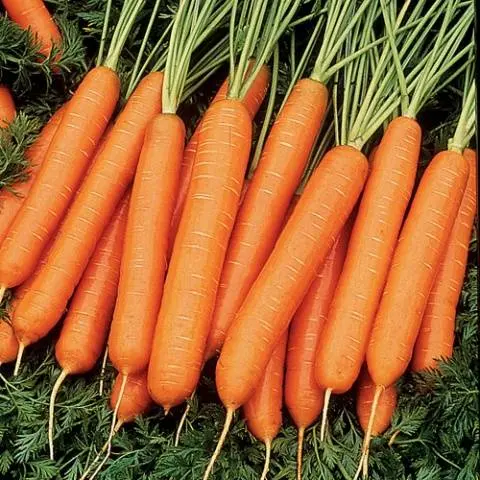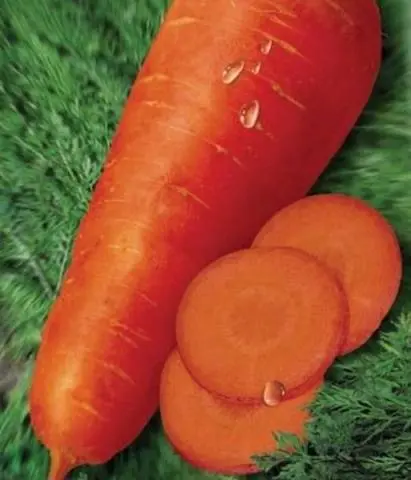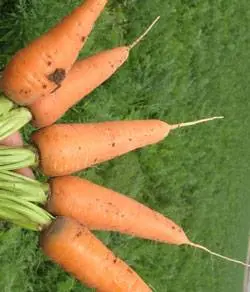Contents
Many common dishes include carrots among the ingredients. In addition to cooking, it is widely used in folk medicine and cosmetics. Growing carrots may seem unpretentious, but in fact this business requires knowledge and adherence to some subtleties.
Overview of carrot varieties for the Leningrad region
In some regions, it is worth planting specially zoned varieties. The following is considered how to choose the best carrots for planting in the Leningrad region.
Nantes 4

This variety belongs to mid-season, before harvesting it takes from 78 to 105 days. Carrots in the form of a cylinder grow 16 cm long, weight is about 100-120 g. The root crop is bright orange in color, the outer surface is even, there are small depressed points.
It has a bright reddish pulp, juicy, aromatic, with a sweet taste. This variety is considered one of the best, suitable for sowing in the winter. High-yielding – about 6 kg. The plant does not resist white and gray rot. Often the variety is used in industrial crops. Root crops are well stored the first half of winter.
Nantes 14
According to key indicators (including the growing season, the characteristics of root crops), the variety differs slightly from Nantes 4. It is also one of the most common varieties of carrots among gardeners. Has excellent taste, is stored better, than the above described.
Losinoostrovskaya 13

The variety belongs to mid-season, about 80-120 days pass before ripening. Carrots reach 15 cm in length, the mass is quite large – 70-155 g. The root crops of the variety grow in the form of a cylinder, the nose can be either blunt or slightly pointed. The outer surface is orange, with small dark patches. It has a pleasant pulp with excellent taste.
The yield of the variety is in the range of 5-6 kg. The plant resists diseases well (it is not affected by rot as often as the Nantes 4 variety). Losinoostrovskaya carrots are characterized by a very high content of carotene, and during storage, its share increases by one and a half times.
Moscow winter A-515

This carrot continues a number of mid-season varieties. Its shape is elongated, cone-shaped, the nose is blunt. The core is up to half of the total diameter, it has a rounded or irregular shape. The flesh is reddish-orange in color, with a good taste.
This variety of carrots is high-yielding. Suitable for winter sowing. It is considered one of the most suitable varieties for long-term storage.
Chantene 2461

The variety bears reddish-orange fruits in the form of a cone with a blunt end. Carrot grows about 12-18 cm long, 4-8 cm in diameter. It belongs to early ripening varieties. It takes up to 95 days before the fruit ripens and the harvest begins. Carrots grow well in loam.
In terms of taste characteristics, the variety is inferior to the varieties mentioned above – Nantes 4 and Nantes 14. However, the fruits last longer.
Khibiny
The next variety, adapted to the conditions of the northwest. We can say that this is a new selection. The plant gives a bountiful harvest, and in a relatively short time. Fruits have excellent taste and are stored for a long time.
There are many varieties that are zoned for the northern regions. Although the choice of varieties is slightly wider in the southern regions, those who live in a cool climate can also start growing carrots.
How to get an early harvest

To get an early harvest, many gardeners sow carrot seeds before winter. This should be done before the arrival of stable frosts, and also choose varieties intended for such cultivation. A bed for winter sowing is isolated on a plot with a slight slope to the south or southwest. Due to the correct location, the soil will thaw faster in the spring, and the water will not stagnate on the surface.
The following are the main points of soil preparation:
- they begin to prepare the bed a month before the planned sowing, until the soil is frozen and it can be dug up well;
- for carrots, a plot is suitable where cabbage, zucchini, cucumbers, onions (any), pumpkin, potatoes were planted this season;
- you can re-plant carrots on the same plot no earlier than after 4 years;
- the soil in the garden is previously freed from the remaining greenery and dug to a depth of 35-40 cm;
- soil is fed with fertilizer.
Humus is used as a fertilizer for planting carrots (1-2 buckets per square meter of soil). You can also use superphosphate (per meter half a tablespoon) or potassium salt (2 teaspoons).
In addition to mineral additives, ordinary ash can be used. During the preparation of the soil per square meter, one glass is enough. If the soil is heavy, add rotted sawdust.
How to prepare a bed for carrots
After digging and fertilizing, the soil must be loosened. Furrows about 5 cm deep are formed on the bed. A gap between them is left 20-25 cm. When the time comes to sow carrot seeds, the grooves will settle and their depth will reach 2-3 cm.
Soil should be poured in advance to fill up the grooves when sowing carrot seeds. Until that time, it will be stored in a warm room.
Sowing is done in frozen ground when low temperatures are established. This usually happens in mid-November. To ensure a sufficient number of seedlings, the seed rate per bed is increased by a quarter. When sowing is completed, the grooves are covered with previously prepared soil. On top it is worth putting a thin layer of peat or humus. When it snows, the bed is additionally covered.
Garden work in early spring
When spring begins, it’s time to return to work in the garden. So that the snow melts faster and the earth begins to warm up, the snow is immediately removed. Sometimes peat is scattered over the surface. Dark top dressing heats up faster in the sun, so the rest of the snow leaves the garden faster.
There is another way to speed up the ripening of carrots. Shelter is installed over the bed. For this:
- fixed along the entire length of the arc beds;
- a non-woven material (film, spunbond, etc.) is laid over the arcs.
List of works when shoots appear
Carrot beds need to be well cared for. The gardener needs:
- loosen the soil;
- free the bed from weeds;
- thin out sprouts;
- fertilize in a timely manner.

Loosening is important because after this procedure, the flow of oxygen to the sprouts improves. When the soil dries, you need to loosen the gaps between the rows.
A couple of weeks after the sprouts emerge, weeds should be removed. At the same time, the carrots are thinned out. A distance of 2 cm should remain between plants. After two and a half weeks, thinning is repeated. Now you need to leave 5 cm between the sprouts.
If necessary, the soil can be fertilized again. To do this, nitrogen fertilizer is applied along the grooves in the proportion of half a tablespoon per square meter. With winter planting, a fresh crop of carrots can be obtained already in the first half of June.
Harvest details
Harvested at different times. They are determined by the characteristics of the variety. First, carrots planted in winter are harvested. When thinning is carried out a second time, young vegetables of any variety are already suitable for consumption. The established standard for ripe carrots is 3 cm in diameter.
Thorough cleaning is carried out before frosts. Usually this time is at the end of September. The method of harvesting carrots is also determined by the characteristics of the variety. If the roots are short or medium in length, they are pulled out with tops. For long carrots, you will need a shovel or pitchfork. Next, the crop is sorted. For long-term storage, only intact fruits of the corresponding varieties are left.
Carrots are one of the cold-resistant crops. However, when planting in a northwestern climate, it is recommended to give preference to zoned varieties. Many gardeners practice winter planting of a number of varieties. It allows you to get a crop of carrots in early June.









